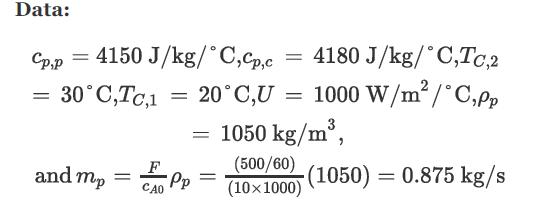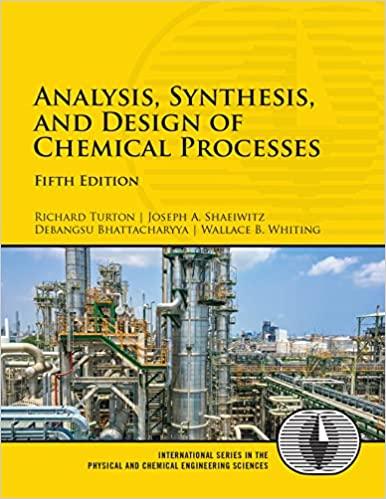The problem statement for Example 22.8 was given as follows: An exothermic, liquid-phase reaction is to take
Question:
The problem statement for Example 22.8 was given as follows: An exothermic, liquid-phase reaction is to take place in a stirred tank reactor. The feed to the reactor (F)
is pure A at 500 mol/min with a concentration of 10 mol/L. The volume of the reactor is 100 L, and the feed temperature is 30°C. A reaction takes place in which A is converted to B (A → B) by a first-order reaction:![1650 3e TIK CA[mol/m/s] (E22.14a) -TA=kCA = 3e TIK]](https://dsd5zvtm8ll6.cloudfront.net/images/question_images/1699/4/4/0/111654b65efbc51e1699440109712.jpg)
The heat of reaction (−ΔHr) is 75,240 J/mol, and it is approximately constant from 30°C−200°C. Other data for the process and coolant are as follows:
In Example 22.8, the conversion was controlled at 80%
by maintaining the reactor temperature at 93.5°C using cooling water entering the reactor at 20°C and leaving at 30°C. The mass flowrate of cooling water was calculated to be 6.486 kg/s, and the required area for heat transfer was 3.96 m2.
The reactor designed in this example was implemented and runs as predicted. However, it has been decided to increase the flow of reactant to 600 mol/min keeping the inlet concentration at 10 mol/L. What must the cooling water’s flowrate and exit temperature be in order to maintain the conversion at 80%?
Example 22.8
An exothermic, liquid-phase reaction is to take place in a stirred tank reactor. The feed to the reactor (F) is pure A at 500 mol/min with a concentration of 10 mol/L. The volume of the reactor is 100 L, and the feed temperature is 30°C. A reaction takes place in which A is converted to B (A ® B) by a first-order reaction:![1650 -TA = KCA = 3e TK CA[mol/m/s]](https://dsd5zvtm8ll6.cloudfront.net/images/question_images/1699/4/3/9/528654b63a8ae7501699439526952.jpg)
The heat of reaction (−ΔH ) is 75,240 J/mol, and it is approximately constant from 30°C to 200°C. Other data for the process and coolant are as follows:
For this system, calculate the following:
1. If the reactor is to be run adiabatically (no coolant), at what temperature and conversion will the reactor run?
2. If it is desired to obtain 80% conversion, at what temperature must the reaction run?
3. For the case in Part (b), what must be the flow of coolant fed to the cooling coil in the reactor?
4. What heat transfer area is required for Part (c)?
Step by Step Answer:

Analysis Synthesis And Design Of Chemical Processes
ISBN: 9780134177403
5th Edition
Authors: Richard Turton, Joseph Shaeiwitz, Debangsu Bhattacharyya, Wallace Whiting





